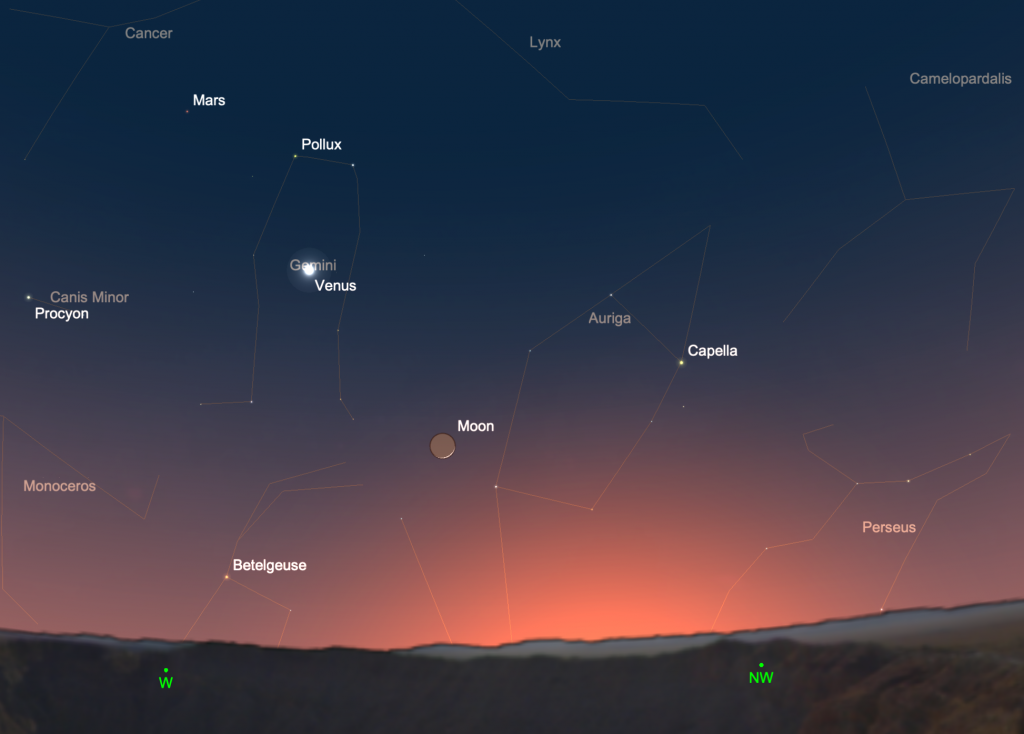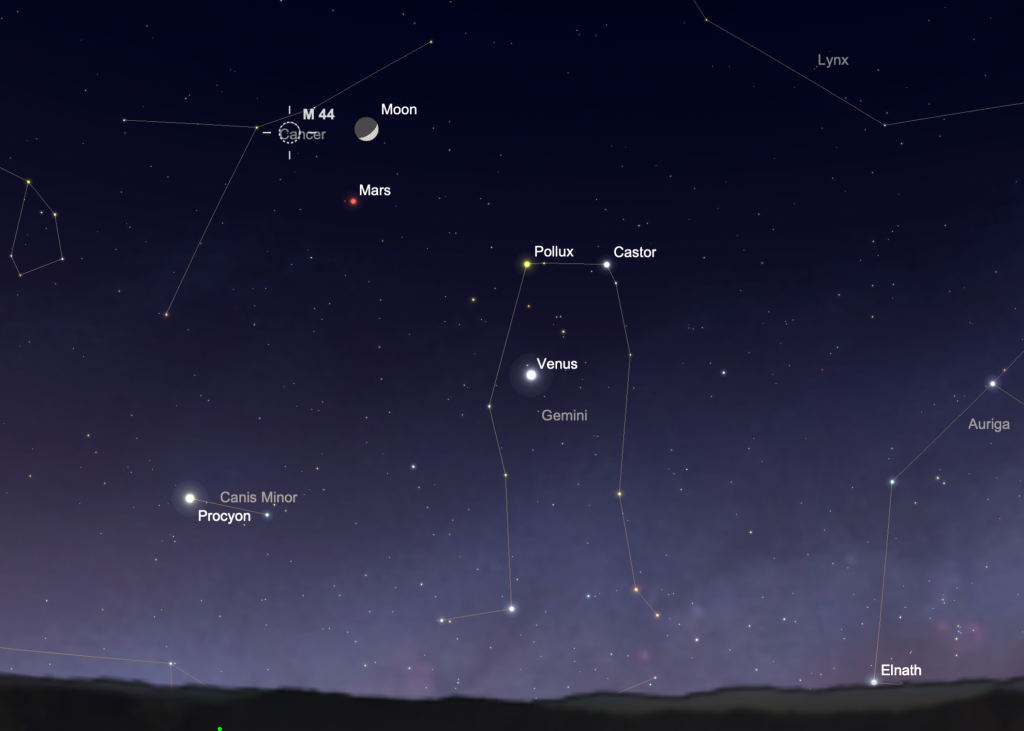
(Looking for last month’s ‘Night Sky’? Find it at this link…)
Brilliant Venus grabs the attention of stargazers all over the world as it rises high and brightens in the May evening sky. The planet lies at the northern edge of the ecliptic, and on May 9 reaches its maximum northerly declination when observers at mid-northern latitudes can see the planet until after midnight. Venus also passes close to the Moon and many bright stars in the western sky throughout the month. Mars also lingers in the west, while Jupiter and Saturn appear low in the east before sunrise. The best meteor shower of the year for southern observers, the Eta Aquariids, is already underway and peaks on May 6 just after the full Moon. But look for these meteors earlier in the week after midnight when the Moon is less of a factor. Here’s what to see in the night sky this month.
5 May. Full Moon, 17:34 UTC (the ‘Flower Moon’).
5 May. Observers in most of Europe, Africa, Australia, and New Zealand can see a penumbral lunar eclipse as the Moon enters the outer reaches of the Earth’s shadow. Peak eclipse occurs at 15:22 UTC, and you can perceive darkening on the full moon for (very approximately) 45 minutes on either side of this time. Get more details and precise timing for your location at this link.
6 May. The usually reliable Eta Aquarid meteor shower peaks. The shower runs from April 21 through May 20 each year, with many meteors still visible for several days on either side of the peak. The Eta Aquarids occur as Earth passes through a stream of icy and dusty debris from Comet 1/P Halley, more commonly called Halley’s Comet. We pass through a second stream of the comet in late October during the Orionids meteor shower. Look for the meteors anywhere in the sky, preferably after midnight. They trace their paths back to a point near the star Eta Aquarii which rises in the eastern/southeastern sky before dawn. This is perhaps the best meteor shower of the year for southern hemisphere stargazers, but northern observers may see a few of these meteors too. NOTE: If you’re clouded out, you can always watch some of the shower on the excellent live feed from the Subaru Telescope on Mauna Kea, Hawaii.
7 May. The still-bright gibbous Moon finds itself about two degrees west of Antares in Scorpius in the southeastern sky late in the evening.
9 May. Wander out and see Mars about 5o south of the bright star Pollux in the west-northwestern sky as darkness falls. The planet has faded to magnitude +1.6 and shrunk to just 5” across, but it continues to wander through the northwestern sky after sunset in the coming days and weeks. Look also for much brighter Venus (magnitude -4.2) to the west in one of the ‘feet’ of Gemini. Today, it lies about 2o north of the star cluster M35 – a great sight in binoculars or small scope!
12 May. Last Quarter Moon, 14:28 UTC

13 May. The fat crescent Moon and Saturn rise together in the east before dawn as the ringed planet lies about 5o north of the Moon in Aquarius. The planet shines at magnitude +1.0 and spans about 16” (not including rings). It continues to rise earlier each day and works its way into the evening sky later in the year.
17 May. Jupiter recently emerged into the morning sky and it’s wasting no time grabbing attention. Today it lies less than one degree from a slender waning crescent Moon, and observers western North and Central America can see a rare occultation of Jupiter before sunrise (observers in the eastern Americas and Europe can see the occultation by day). For those observing before sunrise, the Moon will lie just a few degrees over the horizon which makes for a challenging observation. Observers looking for the occultation by day see the pair at a higher elevation but will likely need some electronic and optical help to find them. The planet disappears behind the thin lunar ‘bright’ side and reappears from behind the ‘dark’ side. Find precise timings for many locations at this link.

19 May. New Moon, 15:53 UTC
21 May. Brilliant Venus forms a triangle with Castor and Pollux in the northwestern sky after sunset. The planet lies to the west of (below) the two stars. A slender crescent Moon lies closer to the horizon, and over the next two days passes within 5o of Venus.

24 May. The crescent Moon, Mars, and the Beehive star cluster M44 form a small triangle about 5o wide in the west after sunset. A pair of binoculars help you take it all in and see the little flock of stars in the famous star cluster.
27 May. First Quarter Moon, 15:22 UTC
31 May. Mars lies on the western edge of the Beehive star cluster (M44) and presents a fantastic sight in binoculars or small telescope. It’s a great photo-op as well.